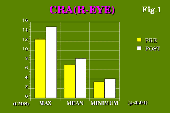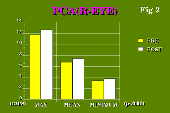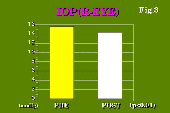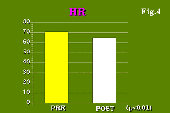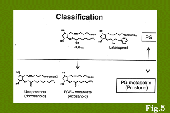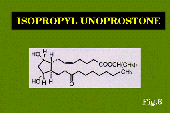Invited Symposium: Glaucoma: Diagnosis and Therapy
| INABIS '98 Home Page | Your Session | Symposia & Poster Sessions | Plenary Sessions | Exhibitors' Foyer | Personal Itinerary | New Search |
Introduction
Recently, the role of the ocular blood circulation is often discussed in the glaucoma research field. Some eye drops are confirmed to improve ocular blood circulation assessed by color Doppler imaging.
Unoprostone (ResculaR) is a prostaglandin-related compound which lowers the intraocular pressure in human by increasing the trabecular and uveoscleral aqueous outflow and causes no effect on the pupil or accommodation.1 Sugiyama2 measured the change of the ocular blood flow in rabbits after the topical application with unoprostone by using thermography. He concluded that topically applied unoprostone had a favorable effect upon the ocular circulation in rabbits. We investigated the change of the ocular blood flow after the topical instillation of unoprostone eye drops on the right eye of the normal subjects by using color Doppler imaging.
Materials and Methods
Method
The LOGIQ500 color Doppler unit (GE Medical System) with a 6.5MHz linear phase transducer was used to examine all of the subjects. Color-encoded blood flow of the central retinal artery (CRA) can be seen in the B-scan image of the optic nerve. The short posterior ciliary artery (PCA) is depicted just adjacent to the optic nerve within the retrobulbar space. The change of ocular blood flow was investigated after the topical instillation of unoprostone eye drops on the right eye of the normal subjects using color Doppler imaging. Both eyes of all the subjects were checked by the same examiners (YI,AN). Before and two hours after the application of unoprostone eye drops, we performed color Doppler imaging and pulse Doppler method to detect the blood flow of the CRA and PCA. The intraocular pressure, systemic blood pressure and pulse rate of all the subjects were measured before and two hours after the instillation of the eye drops.
Subjects
Eighteen normal subjects were examined. Fourteen subjects were
female and four were male. The ages of the subjects ranged from 60 to 84
years old. The mean age was 71 years old. After precise explanations of
the procedure were given, consent was granted by all of the subjects.
Results
Peak-systolic, mean, and end-diastolic blood flow velocities were increased after the application of unoprostone eye drops for both CRA and PCA. (p<0.01, Fig.1,2) Pulsatility indices were not changed in either vessels. The intraocular pressure was significantly decreased. (p<0.01, Fig.3) Heart rate was significantly decreased. (p<0.01, Fig.4) The systolic and diastolic systemic blood pressure was not changed.
Discussion and Conclusion
Discussion
Unoprostone (ResculaR) is a novel prostaglandin-related compound produced by Ueno Fine Chemicals Industry Ltd. (Osaka, Japan). Unoprostone lowers the intraocular pressure by increasing the trabecular and uveoscleral aqueous outflow and has no effect on the pupil and accommodation.1 Unoprostone is similar to Latanoprost but different from Latanoprost in several points.(Fig.5) The Latanoprost is a direct derivative of the PGF2-alpha. Unoprostone is a derivative of the non-active metabolized PGF2-alpha and its pharmacological effect is weaker than the Latanoprost.(Fig.6) Latanoprost causes the iris color change. Unoprostone doesn't have such a side effect. Sugiyama2 measured the change of the ocular blood flow in rabbits after the topical application of unoprostone by using thermography. He concluded that topically applied unoprostone has a favorable effect upon the ocular blood circulation in rabbits.
In human eyes, the improvement of the chorio-retinal blood circulation
was assessed by using a laser speckle tissue circulation analyzer for the
application of the unoprostone eye drops3. In the rabbits' eyes, the improvement
of the choroidal blood circulation was assessed by using the hydrogen clearance
method for the application of the unoprostone eye drops.4,5 In this experiment,
we found that topically applied unoprostone improves the ocular blood circulation.
It is very important to estimate the effect of glaucoma drugs on the ocular
blood circulation with regard to glaucoma therapy. The ocular blood flow
can be assessed by laser Doppler, laser speckle and color Doppler imaging
method. The color Doppler imaging can only measure the blood flow in the
short posterior ciliary artery which locates around the lamina cribrosa
of the optic nerve. It is clear that the most susceptive point of the axon
fiber against the intraocular pressure is around the lamina cribrosa where
the supporting connective tissue is weaker than the other area of the eye.
I believe that the color Doppler imaging is the best way to evaluate the
ocular blood circulation in the glaucomas among these three methods.
Conclusions
Unoprostone eye drops not only lowers the intraocular pressure but
also improves the ocular blood circulation of the retina and optic nerve
around the lamina cribrosa in human eyes. Unoprostone has no unfavorable
effect on the peripheral vascular resistance either the iris color in human
eyes. The color Doppler imaging is the most suitable method to assess the
ocular blood circulation in glaucoma.
References
- Sakurai, M., Araie, M., Oshika, T. et al.: Effects of topical application
of UF-021, a novel prostaglandin derivative, on aqueous humor dynamics in
normal human eyes. Jpn. J. Ophthalmol. 35:156-165 (1991)
- Sugiyama, T., Tokuoka,S., Nakajima,M. and Azuma, I.: Changes in Rabbit
Capillary Blood Flow and Corneal Temperature with Topically Applied UF-021,
Bunazocin Hydrochloride and Propranolol Hydrochloride. Atarashii Ganka Journal
of the Eye. 9:1430-1434 (1992)
- Kojima, S., Sugiyama, T., Azuma, I, Konishi, N and Fujii, H.: Effect
of Topically Applied Isopropyl Unoprostone on Microcirculation in the Human
Ocular Fundus Evaluated with a Laser Speckle Microcirculation Analyzer.
Journal of Japanese Ophthalmological Society. 7:605-610 (1997)
- Ogo, T.: Effect of Isopropyl Unoprostone on Choroidal Circulation-1 Changes
in Choroidal Blood Flow and Intraocular Pressure with Topical Application. Folia Ophthalmol Jpn 47:268-272 (1996)
- Ogo, T.: Effect of Isopropyl Unoprostone on Choroidal Circulation-2 Changes
in Choroidal Blood Flow under Constant Intraocular Pressure-. Folia Ophthalmol
Jpn 47:1398-1403 (1996)
| Discussion Board | Previous Page | Your Symposium |
